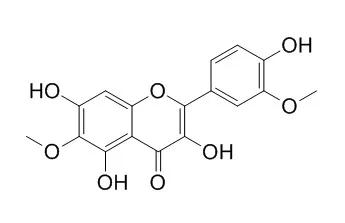| In vitro: |
| Front Pharmacol. 2018 Jul 30;9:824. | | Spinacetin Suppresses the Mast Cell Activation and Passive Cutaneous Anaphylaxis in Mouse Model.[Pubmed: 30104977 ] | We previously reported the anti-inflammatory and anti-asthmatic activities of the extract of the Inula japonica Thunb. Aiming for discovery of a novel anti-inflammatory compound, we isolated Spinacetin from the extract and investigated its in vitro and in vivo anti-inflammatory effect and the related mechanism.
METHODS AND RESULTS:
Effect of Spinacetin on the Syk signaling pathway was studied in bone marrow-derived mast cells (BMMCs), and that on the nuclear factor-κB (NF-κB) and mitogen-activated protein kinases (MAPKs) was investigated in Rat basophilic leukemia (RBL)-2H3 cells and human mast cell line (HMC-1). The in vivo anti-inflammatory activity was assessed with passive cutaneous anaphylaxis (PCA) reaction assay. Spinacetin significantly inhibited the release of histamine, and production of inflammatory mediators such as leukotriene C4 (LTC4) and interlukin-6 (IL-6) in IgE/Ag stimulated BMMCs. Analysis of the signaling pathways demonstrated that Spinacetin inhibited activation of Syk, linker of activated T cells (LAT), phospholipase Cγ (PLCγ), cytosolic phospholipase A2 (cPLA2), MAPKs, Akt/NF-κB, and intracellular Ca2+ mobilization but with no effect on Fyn and Lyn. On the other hand, Spinacetin suppressed IgE/Ag-induced activation of RBL-2H3 cells with inhibition against phosphorylation of extracellular signal regulated-protein kinase (ERK), c-Jun-NH2-terminal kinase (JNK), p38 MAPKs, PLCγ, translocation of cPLA2, and Akt/IκBα/NF-κB signal. However, Spinacetin had no effect on PMA and A23187-induced activation of HMC-1. Furthermore, oral administration of Spinacetin dose-dependently attenuated IgE/Ag-mediated PCA reaction in mouse model.
CONCLUSIONS:
Taken together, Spinacetin showed the activities in preventing inflammatory processes, which might be at least partially attributed to the abolishment of Syk-dependent activation of IgE/Ag-mediated mast cells. | | Nat Prod Res. 2013;27(11):1007-11. | | Spasmolytic activity of Artemisia copa aqueous extract and isolated compounds.[Pubmed: 22577954 ] | Artemisia copa Phil. (Compositae) is used in popular medicine as a digestive and for gastric pains.
METHODS AND RESULTS:
The effects of A. copa aqueous extract and its isolated compounds were evaluated on isolated rat jejunum. The extract inhibited non-competitively the cumulative concentration-response curves induced by acetylcholine and CaCl2. The tonic jejunum contractions induced by 80 mM KCl were inhibited by A. copa. Relaxant effects of A. copa on the tonic contraction induced by 25 mM KCl, [EC50: 0.94 mg mL(-1) (0.64-1.39)], was not inhibited by glibenclamide, TEA, l-NAME or methylene blue. Chrysoeriol, Spinacetin and luteolin (30 µg mL(-1)), produced an antagonism on the CaCl2 concentration-response curve, showing an inhibition of the maximum contractions (70.0% ± 5.0%, 49.1% ± 4.5% and 77.0% ± 3.5% of E max, respectively), whereas tricin did not inhibit when the same concentration was used.
CONCLUSIONS:
A. copa exerts spasmolytic activity by blocking calcium channels and three isolated compounds could be, at least partly, responsible for the effect. |
|






 Cell. 2018 Jan 11;172(1-2):249-261.e12. doi: 10.1016/j.cell.2017.12.019.IF=36.216(2019)
Cell. 2018 Jan 11;172(1-2):249-261.e12. doi: 10.1016/j.cell.2017.12.019.IF=36.216(2019) Cell Metab. 2020 Mar 3;31(3):534-548.e5. doi: 10.1016/j.cmet.2020.01.002.IF=22.415(2019)
Cell Metab. 2020 Mar 3;31(3):534-548.e5. doi: 10.1016/j.cmet.2020.01.002.IF=22.415(2019) Mol Cell. 2017 Nov 16;68(4):673-685.e6. doi: 10.1016/j.molcel.2017.10.022.IF=14.548(2019)
Mol Cell. 2017 Nov 16;68(4):673-685.e6. doi: 10.1016/j.molcel.2017.10.022.IF=14.548(2019)